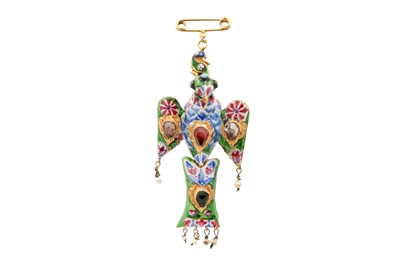29th Apr, 2022 11:00
Islamic Art - Property of a European Collector Part III
A POLYCHROME-ENAMELLED BIRD PENDANT
Qajar Iran, 19th century
A POLYCHROME-ENAMELLED BIRD PENDANT
PROPERTY FROM AN IMPORTANT EUROPEAN PRIVATE COLLECTION
Qajar Iran, 19th century
In the shape of an eagle with open wings, caparisoned on the tail and lower tip of the wings, the body painted in pink, green, cobalt blue and white enamels, the chainlet at the back with an enamelled 'S' charm attached to the safety pin a later addition, the eyes encrusted with turquoise beads, the other faceted glass beads on the breast and wings a later replacement imitating diamonds, rubies, and emeralds, 6cm x 3cm.
The pendant in our lot is almost identical in shape and design to a pendant dating to the first half of the 19th century, that was possibly once used as an aigrette (turban ornament). This pendant is housed in the Doha Museum of Islamic Art (inv. no. JE.7.1997), and was published in G. Fellinger, L'Empire des Roses, 2018, cat. 176, p. 167. The main difference with our example is the lack of both the pearl hanging from the eagle's beak and the original precious stones set on the bird's breast and wings.
Pendants of this form and design do not seem to have been prominent in Iran prior to the Qajar period. It is plausible that the inspiration for such creations was drawn from elsewhere. Eagle pendants were certainly popular and en vogue at the Northern Indian Mughal and Deccani courts since at least the second half of the 16th century. Usually made of gold and clad in precious stones set with a truly autochthonous Indian technique employing hyper-purified 24ct gold foil called kundan, these pendants could have been conceived as a local response to European heraldic birds, which were very popular in the 16th and 17th centuries. Such figures were introduced to India by Italian craftsmen working at the Mughal court. To view how these pendants would have been worn in India, please see the portrait of Maharana Amar Singh (ca. 1735 - 40) in the Victoria and Albert Museum's collection (A. Jaffer, Treasures of the Mughals and the Maharajas: The Al Thani Collection, 2017, p. 212) and for further comparative examples, please see A. Jaffer, Treasures of the Mughals and the Maharajas: The Al Thani Collection, 2017, cats. 145, 146 and 147, pp. 213 - 215; and M. Keene, Treasury of the World, 2001, cats. 8.38 - 40, pp. 108 - 109.
Dimensions: 6cm x 3cm
Sold for £1,750
Includes Buyer's Premium
Do you have an item similar to the item above? If so please click the link below to request a free online valuation through our website.


